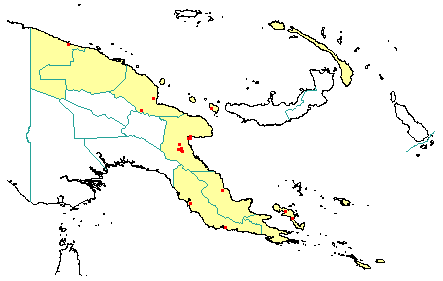
in PNGplants database
PNGTreesKey – Garuga floribunda Decne. |
Barry Conn (NSW) & Kipiro Damas (LAE).
Guide to trees of Papua New Guinea
Copyright held by the authors, National Herbarium of New South Wales, and Papua New Guinea National Herbarium
Nouvelles Annales du Museum d'Histoire Naturelle Vol. 3: 477 (1834)
Other Literature: P.W. Leenhouts, Flora Malesiana, Series 1, 215-218 (1956) Fig. 5-6.
Family: Burseraceae
Dicotyledon
Timber Group: Minor hardwood
Field Characters: Large canopy tree (30-36 m high); Bole cylindrical (50-90 cm diam.); straight (bole 20-25 m long); buttresses buttresses present; spines spines absent; aerial roots aerial roots absent; stilt roots stilt roots absent; Bark grey or dark brown, slightly rough or smooth, slightly pustular, scaly or flaky (flakes irregular), fissured, or peeling, lenticels irregular; Subrhytidome (under-bark) red (pale (flesh-coloured) or reddish brown; sometimes less than 25 mm thick or more than 25 mm thick, (15.0-) 45.0-50.0; bark blaze consisting of one layer; faintly to non-aromatic; pleasant (fruity aroma) or faintly resinous/linament-like; outer blaze red, pink, or pale brown, markings absent or with stripes, fibrous; inner blaze red, pink, or pale brown, with stripes or markings absent, fibrous; bark exudate (sap) present, white/milky or colourless, not readily flowing (spotty), colour not changing on exposure to air, sticky (resinous); terminal buds not enclosed by leaves.
Indumentum: Complex hairs absent; stinging hairs absent; mature twig indumentum (hairs) present when young or later absent, hairs dense to sparse.
Leaves: Leaves clustered at end of branches, spiral (leaves occurring singly at a node and arranged spirally up the branchlet), compound (a leaf made up from two or more leaflets); petiole present, not winged, attached to base of leaf blade, swollen; leaves pinnate (unbranched with more than three leaflets); petiolule not swollen; rachis present, absent, absent; leaves with a terminal leaflet (the number of leaflets odd - imparipinnate), broadest at or near middle to equally broad throughout much of length, 4.0-19.0 cm, 2.0-5.0 (-7.0) cm, leaflets opposite, slightly asymmetric or symmetric, terminal developing leaflet buds straight; venation pinnate, secondary veins open, prominent, intramarginal veins absent; leaves lower surface green, upper surface dark green, indumentum (hairs) absent when mature or present when immature, indumentum (hairs) dense to sparse; absent; domatia absent; stipules present, free, laterally placed, not encircling the twig, leafy, not fringed, large, not persistent.
Flowers: Inflorescence axillary, flowers on a branched axis, cones absent; flowers bisexual, stalked, flowers with many planes of symmetry, 4.0-5.0 mm long, diameter small (up to10 mm diam.) (4-5 mm diam.); perianth present, with distinct sepals and petals whorls, inner perianth white to yellow to pink (sometimes (slightly); 5, some or partly joined; stamens 10, present, free of each other, joined to the perianth; ovary superior, carpels joined (when more than one), locules 3-5; styles solitary (hairy at base), 1.
Fruits: Infrutescence arranged on branched axis (fruit 3- to 5-angled), fruit (5.0-) 8.0-10.0 mm long, 8.0-10.0 mm diam., dark green or brown (inside translucent green and jelly-like), not spiny, non-fleshy, simple, indehiscent, drupe; seeds 1-5, to about 5 mm long (4-6 mm long), not winged, broad (as wide as long), seed 1-10 mm diam. (c. 4 mm diam.).
Distribution: West Sepik, East Sepik, Madang, Morobe, Central, Northern, Milne Bay, Papuan Islands & New Ireland.
 | Botanical records in PNGplants database |